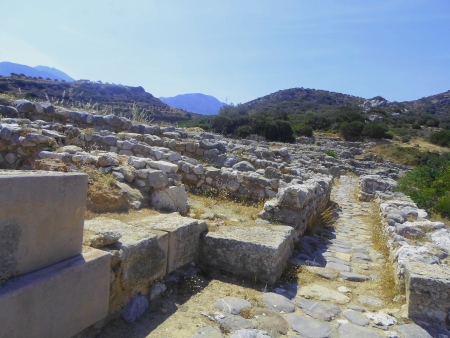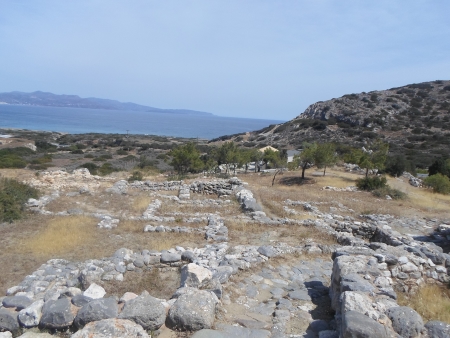|
Gournia Crete |
||
|
|
By car: Gournia is 15 to 20 km away from Agios Nikolaos and Ierapetra. It is relatively easy to find Gournia by rental car. If one drives on the highway Agios Nikolaos to Sitia, Gournia is well signposted. The entrance to the attraction is only about 100 metres from this road. The next bigger place is Pachia Ammos about 2 kilometres east of Gournia.. Coming from the south (Ieraperta) take the road to Agios Nikolaos and Heraklion. If you reach the north coast you are in Pachia Ammos. Turn left. Three kilometres later you see the signpost next to the highway to Agios Nikolaos. 100 metres later you are at the cash desk of Gournia.
The entrance fee is surprisingly only 2 Euro. Students and other groups entitled to discounts pay only one euro (as of May 2016). Opening hours Gournia: Daily except Monday from 8 to 15 o'clock. Like many archaeological sites and museums in Crete, Gournia closes at 3 pm. Some holidays are also closed. You can move freely in the fenced area of Gournia. Laymen of archaeology are often a bit disappointed. You can see walls that are rarely more than half a meter high. All finds were brought to museums. We didn't like the fact that there are several signs pointing to a toilet and a café. In fact, neither the toilet nor the restaurant seems to be in operation. We asked the only employee present at the cash desk. Somewhat unfriendly we were told that the toilet was not ready yet and the cafe was closed. Unfortunately, the lady at the cash desk did not give us any competent answers to technical questions about Gournia. The information boards on the premises are positive. At the highest point you have a good view over the ancient city. Today the sea is about one kilometre to the north.
In former times, in the time of the Minoans, the coast ran differently. The port city of Gournia at that time was of course directly at the sea.. Gournia can also be reached by bus. You simply tell the driver that you want to get off at Gournia. All buses from Agios Nikolaos to Sitia and Ierapetra pass the ruins of the ancient city. Together there is about one bus per hour in each direction. Of course it is much easier to get to Gournia with your own car. Parking is free. There is no real parking place, one simply parks one's car along the field path in front of the entrance. Abu Dhabi Tour: Our guide to day trips from Dubai to Abu Dhabi. The following article describes the Minoan city and the archaeological site in more detail: Gournia is an ancient Minoan port city on the north coast of Crete, about 20 km east of Agios Nikolaos. The Minoan name of the settlement is unknown. The name Gournia (Greek = potion) is based on the cattle potions found in some houses, which are embedded in the ground. There is no stream on the hill of Gournia. Archaeological site Gournia was probably founded in the younger palace period (17th to 15th century BC), according to other sources around 2700 BC by the Minoans. It is grouped around a "manor house" with a wide courtyard. Three streets, which run down stairs from the hill and a ring road are well recognizable. Individual, delimitable quarters can be identified as residential or workshop quarters or as an area of the 'Fürstenhof'. This is located at a central square, which is separated from the remains of a staircase, where again two rows of steps meet at right angles. It can be assumed that this staircase has had cultic significance. Cavities and recesses on the walls of the buildings are evidence of half-timbered construction to protect against earthquakes. Small lattice windows probably divided the half-timbered façade. Some houses were probably multi-storey, so that there was room for supplies and livestock on the ground floor, while the inhabitants lived above them. destructions Around 1450 BC Gournia, like the Minoan palaces, was destroyed. Whether the city fell victim to a tidal wave as a result of the volcanic eruption of Thera/Santorin or an earthquake is unknown. The foundation walls of the houses are preserved up to hip height. But there are still small traces of subsequent Minoan and Mycenaean settlements. Around 1200 BC Gournia was finally destroyed and abandoned. history of discovery The American archaeologist Harriet Boyd-Hawes and a research group from Pennsylvania University discovered the remains of Gournias in 1901 on a small hill on the coastal road to Sitia. She refrained from reconstructing it, as Evans did in Knossos. This article is licensed under the GNU Free Documentation License. It uses material from the Wikipedia article Gournia. A list of authors is available in Wikipedia. Other archaeological sights on the island of Crete - The most important ancient monument on Crete is Knossos near Heraklion. - Two other palaces of the Minoans, like Gournia in Eastern Crete, are the Palace of Zakros and the Palace of Malia. - A little further away are the excavations of Phestos with the famous ring of Phestos. - A visit to Gortys Crete is also interesting. It was the capital of the island in Roman times.
|
|

